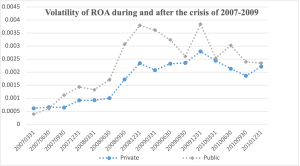In a recent paper, we examine whether listed bank holding companies (BHCs) that are small enough to stay private are riskier than private BHCs that are large enough to go public but have opted not to do so.
Some arguments suggest that listed firms are likely to be riskier than private firms. Among them are that institutional investors (or blockholders) demand superior quarterly earnings results and that strong incentives in top management compensation packages might influence a listed firm’s investment choices. The banking industry is highly competitive, which leads management to seek better financial results and invest in risky projects. Aggressive choices can be enhanced by the scale and growth of the bank. Growth is often not organic but occurs through mergers and acquisitions. The common medium of exchange in bank acquisition is equity. Aggressive incumbents are more likely to take their firms public given that they can scale up through acquisitions, because being listed allows them to issue equity more easily and acquire larger entities. If the firm’s equity is performing well, then acquisitions can become cheaper. Hence, being listed provides an opportunity for top management of some banks to take risks that they may not have taken before going public. Further, realizing that their benchmark for performance is no longer limited to banks in the same region, they now effectively compete with all listed banks, thus putting even more pressure on management to take risks.
A mechanism to control risk is, of course, bank regulators. If listing increases risk taking, and if regulators know it does so, then regulators are likely to be more diligent in assessing bank risk after an initial public offering. If a bank and its managers or board lose discretion because regulatory examinations reveal that the bank has taken unsound and risky investments, then top management is likely to act more conservatively. Thus, listed banks might not be riskier than private banks of comparable size and asset structure. Given the defining role of size in bank business model selection and risk choices, we study banks of comparable size in two cohorts to assess the effect of listing on risk taking.
How much risk banks can undertake also depends on the amount of information in the market. Information provided by equity and credit analysts affects stock prices, and more information is generally available about listed firms. Equity and credit prices and their volatility could influence supervisors’ perception of banks’ risk and provide another channel for regulators to assess the health of financial firms. Information production in the market might be more intense during poor economic conditions, such as during the financial crisis.
To assess bank risk for private and public firms, we construct a quarterly sample over the years 1990-2019. This time frame covers the period of growth and development in the financial industry prior to the financial crisis, the turmoil during the crisis, the period when regulation was tightened, and the subsequent recovery following the crisis. It serves as a useful setting to study the rise and fall of risk-taking within the banking sector, as well as any possible detrimental consequences of improper risk-management. Our proxies for risk are volatility of return on assets (ROA) and return on equity (ROE) as well as publicly available proxies for the components of CAMEL ratings (capital, assets, earnings, and liquidity), non-performing loans, charge-offs, risk-weighted assets, and z-score (a measure of default risk).
Our analysis shows that listed banks are riskier along the whole spectrum of risk metrics that we use, and that they are even riskier during the financial crisis (as shown on the graph):
A potential explanation for the increase in risk during the crisis might be greater regulatory oversight and the changes to accounting rules that impaired the ability of publicly traded banks to manage their earnings as effectively as before. However, the volatility of listed banks’ ROA declines post-crisis while accounting rules and regulatory pressures remain.
We extend our inquiry into risk-taking by studying bank failures that result from the financial crisis in our sample. We find that publicly traded banks are less likely to fail, despite being riskier than private banks. A higher z-score in listed banks also reflects their lower propensity to fail. We also find that listed banks are riskier when there are more uninsured deposits in their total liabilities, when there are more loans in their assets’ composition, when they hold more securities, and when they are larger.
We find that publicly traded banks take more risk than their private counterparts but fail less frequently during the financial crisis. Overall, our findings suggest that it is likely that the financial crisis and subsequent changes in the operating environment facing banks may have contributed to the reduction in risk documented for listed banks relative to private banks.
This post comes to us from financial economist Hamid Mehran and from professors Ajay Patel at Wake Forest University and Nonna Sorokina at The Pennsylvania State University. It is based on their recent paper, “Are Listed Banks Riskier Than Private Banks?” available here.
 Sky Blog
Sky Blog



